Riding a motorcycle isn’t very hard. It takes balance, concentration, and multitasking to use all the controls accurately, but this begins to come naturally with a little practice.
My uncle taught me to ride in a movie theater parking lot, and the first thing he did was go over the essential controls. These are:
- Throttle
- Gears
- Clutch
- Brakes
- Kickstand
Once I knew where everything was, it was time to ride. That meant using those controls to:
- Balance
- Accelerate
- Shift gears
- Brake and stop
- Corner and turn
Along with looking at how to ride a motorcycle, I’ve also got some special tips as well. With this info, you’ll be cruising in no time.
Also read our article on motorcycle pros and cons.
Where Are the Controls?
Let’s familiarize ourselves with the basic motorcycle controls.
Throttle
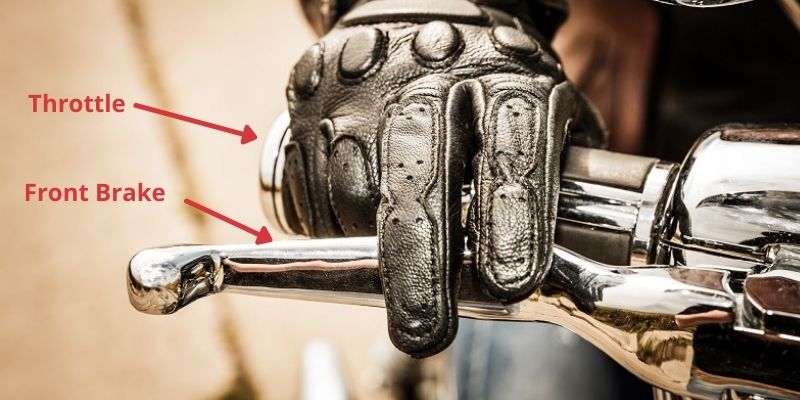
Unlike with a car, you control your motorcycle’s acceleration with your hand, not your foot. Specifically, the throttle is located on the right handlebar. Twisting it down gives the motor gas, causing it to speed up.
Gears
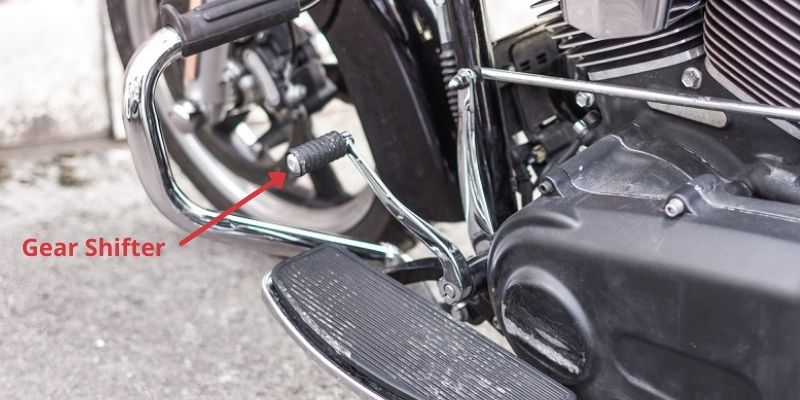
If you drive an automatic car like most Americans these days, you probably don’t think about gears a lot.
On a motorcycle, though, they’re a pretty big part of riding. Lower gears make it easier for the motor to turn the rear wheel, while higher gears give it more power.
As you accelerate, you have to shift up through the gears. We’ll dive into exactly how to do this in a bit.
Clutch
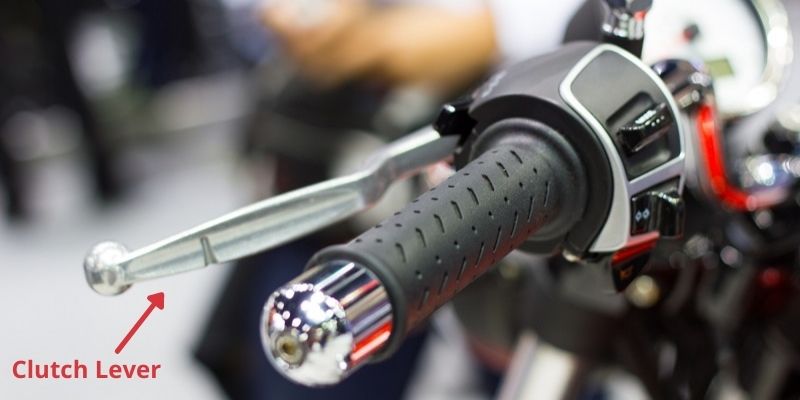
The clutch is the little lever above the left handlebar. If you’re like me, you probably thought that this was a brake like on a bicycle. This is definitely not the case!
The clutch separates the motor from the gears allowing you to shift gears. Again, we’ll get into how to do this later, but take note of the clutch’s location.
Brakes
Honestly, brakes on a motorcycle aren’t very intuitive, especially not compared to a bicycle. That’s mainly because there are two different brakes in two different places, one for the rear wheel and one for the front (See front brake position in the first image above next to the throttle).
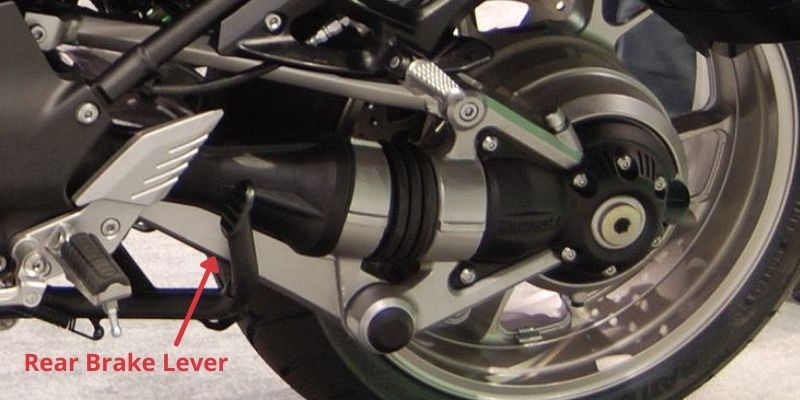
The rear brake is controlled by a lever behind your right foot, while the lever above the right handlebar controls the front brake. Using these in a coordinated way is essential to safe riding, so we’ll go over that below.
Kickstand
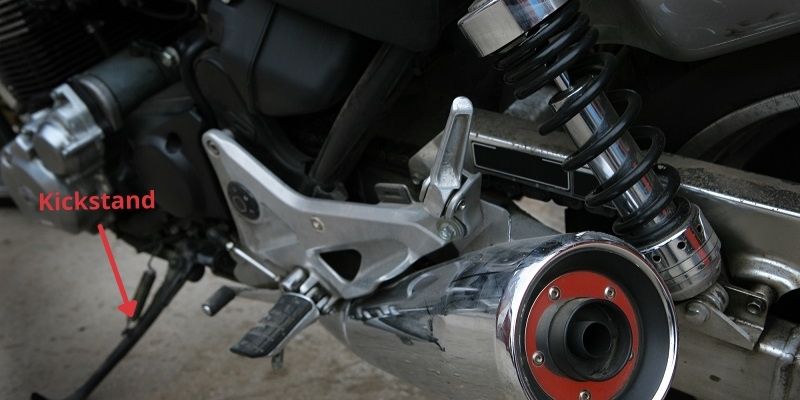
Your kickstand is just a little leg that you can extend from your bike to keep it upright when you leave it. It’s usually on the left side, but it depends on which side the chain is on.
When you’re ready to get off your motorcycle, come to a complete stop first, plant both feet firmly on the ground on either side of the bike, and turn it off.
Then, with the motorcycle still perfectly upright, extend the kickstand.
Lastly, lean the motorcycle down till it’s supported by the kickstand and turn the front wheel towards the curb.
Some motorcycles also have an additional center kickstand that fully lifts the motorcycle off the ground when it’s not in use.
To deploy this, stand on the side of the motorcycle where the center stand has its footpeg. Place one hand on the handlebars and another on the rear of the bike. Step onto the center stand while pulling the bike backward, using your weight to deploy and lift the motorcycle.
This video shows the basic steps.
How to Ride a Motorcycle: The Hard Stuff
Balance
Balance is usually one of the biggest concerns new motorcycle riders have. Compared to a bicycle, a big motorcycle weighing hundreds of pounds can be intimidating. In reality, though, it’s basically the same.
With just a little bit of speed, often just the idle, you’ll be surprised how easily the motorcycle manages to keep itself upright with little effort on your part. The main thing is learning at what point to put down your foot when you’re slowing down and how to keep the bike balanced at a stop.
A good way to get a feel for the weight and balance of a motorcycle is to start by standing above the motorcycle with your legs firmly planted on either side. Move it slowly from side to side till you get a feel for the point when the motorcycle begins to tip, and it takes a lot of strength to keep it upright.
When you start riding, position yourself correctly. Most importantly, grip the gas tank tightly with your thighs to give you good control. Pay attention to when the motorcycle starts to wobble. At this point, you’ll have to put your foot down or hit the throttle to give yourself some speed.
Related: What causes death wobble?
It’s highly recommended that you know how to ride a bicycle before jumping on a motorcycle.
Accelerating
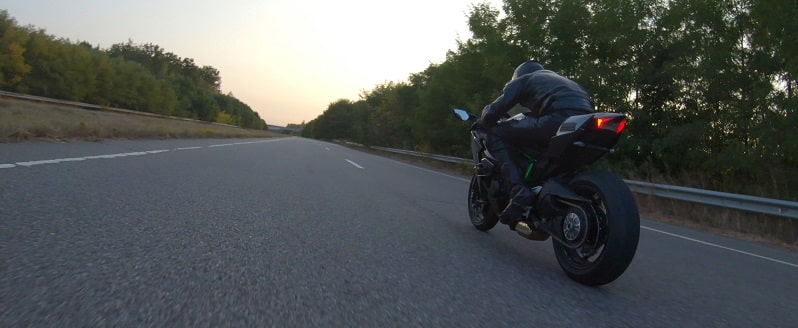
On the face of it, accelerating is pretty simple. You just roll the throttle back. However, you should practice getting a feel for how much the bike accelerates with how much roll, especially because each bike is a bit different in this regard.
One thing to be careful of is accidentally accelerating. This can happen when you reach for the front brake. Similarly, you should try to keep your wrists level because you relax them downward; it will be difficult to roll the throttle effectively when you need to.
Of course, when you accelerate, you have to shift up through the gears, so let’s dive into that now.
Shifting Gears
Shifting gears is arguably the hardest part of learning to ride a motorcycle. If you know how to drive a manual car, you have a bit of a head start, but it’s still very different.
The toughest aspect of shifting gears is that you have to do it with your right foot. The gear-shift lever is positioned just above your right toe, and you’ll move it up with your toe or push it down by stepping on it to change gears. Of course, as you do this, you need to be gripping the clutch with your left hand.
Okay, now for the tricky part. The first gear is above neutral, while the other four gears are below. In other words, to go from neutral to first, you push the lever with your foot. Then from first to second, you have to push it down. Same for second to third. Neutral itself is a half step between first and second, sometimes making it hard to find.
Read: Motorcycle won’t go into neutral
Shifting gears accurately is important for your safety. For instance, if you want to stop and shift from first to neutral but accidentally go down to second, you may accelerate unexpectedly and have an accident.
To help prevent this, motorcycle transmissions are sequential. Unlike in cars, it’s impossible to shift to a gear that isn’t immediately above or below the one you’re on. For example, you can’t shift from second to fourth, only from second to first or third. This kind of transmission is also smoother and faster to prevent jerking, which could be dangerous on a motorcycle.
Also see what RPM to shift gears on a motorcycle
Braking and Stopping
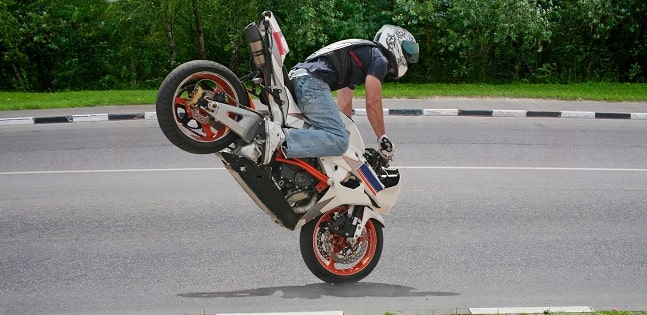
There’s a bit of debate in the motorcycle world about “correct” braking. A lot of motorcyclists insist that the front brake is all you need. While the front brake is indeed the more powerful of the two and the one you should prioritize, the rear brake serves an important purpose, and there are times when you should use it first.
When coming to a normal, gradual stop, the safest way to brake is to apply both brakes with equal pressure at the same time.
However, with more abrupt stops, really pay attention to the front brake.
As you stop, the weight of the motorcycle shifts to the front, meaning the back wheel has little traction, and the rear brake doesn’t do much to slow down the bike.
At the same time, gripping the front brake too hard while all the weight is on the front wheel could cause the brakes to lock up. Then you can skid and lose control. Pump the front brake gradually and use the rear brake to help out a bit.
There is a time when the rear brake becomes essential, and that’s cornering. Let’s go over that in more detail.
Cornering and Turning
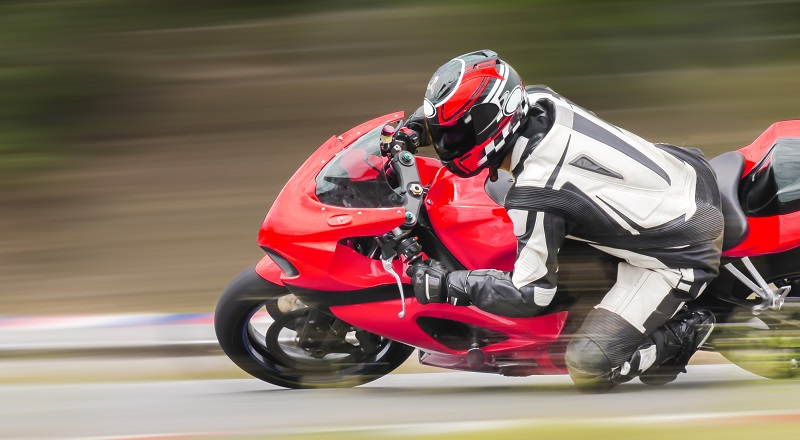
Turning your motorcycle is one of the most intimidating parts of riding. I know the first time I tried a turn, I felt sure I’d tip the bike over. As a result, I went way too slow, which almost threw me off the bike, not the turn itself.
What most beginners have trouble with is that steering your motorcycle doesn’t involve turning the front wheel but rather leaning the motorcycle over. If you lean to the left, it will turn to the left.
Now, you may have seen motorcycle racers lean deeply into a turn with their bodies going down farther than the bikes until their knees nearly touch the roadway. The idea here is to turn the motorcycle while still keeping the maximum amount of tire on the ground to increase speed.
For beginners and even normal non-racing motorcyclists, this isn’t advised. Instead, you should keep your body parallel to the motorcycle. If you lean the bike 45 degrees, lean your body 45 degrees too.
When you approach a turn, you should slow down a bit by letting off the throttle—just not so much that you lose balance like me. Then, as you come around the turn, accelerate your way out of it.
You should go with the rear brake on really tight curves where you have to slow down a lot. The front brake is too powerful and could cause the bike to fall over when it’s leaned so far toward the ground.
Plus, slowing down with the rear brake allows you to keep giving the bike a bit of throttle to maintain balance and accelerate out of the curve.
Other Beginner Rider Tips
Motorcycle Training and Safety Courses
Because I’m a cheapskate, I opted to have my uncle “teach” me to ride a motorcycle in the parking lot of our local movie theater. Considering he spent most of the time napping in his car, I’m lucky I didn’t crash into a light pole.
Motorcycle training courses are great options to learn to ride quickly and safely, and they’re usually not that expensive either. Plus, they can often help you skip some of the licensing process.
These courses have a proven all-inclusive methodology that takes you from the basics through every aspect of riding. This way, you don’t get to your license test—or worse, on the freeway—and realize there’s something you don’t know how to do.
Go Ahead and Get Your Gear
You might be tempted to wait and get your gear like helmet, gloves, and jacket until you’ve finished learning how to ride. Really though, it’s a better idea to have all that stuff first. This way you can learn to ride with them.
Otherwise, you might buy all your gear only to find that your gloves make rolling the throttle feel a lot different. Now you’ll have to relearn acceleration.
Check out our motorcycle gear guides and reviews.
Avoid Rush Hour for a While
Whether you take a course or teach yourself in a parking lot, you’ll have to graduate to the real road at some point. Even if you have your license and feel comfortable on the bike, you should avoid the busiest times for a while.
Of course, more cars on the road means more danger for you, but that’s not all.
More cars mean more stress.
You might get nervous if you’re first at a red light, wanting to accelerate and not anger the cars behind you. You might accelerate too quickly or shift gears incorrectly and have an accident. Wait till all of this is instinctive before you take on rush hour.
FAQ
How long does it take to learn to ride a motorcycle?
The short answer is a day or two. Many safety courses take place over a single weekend. For example, Harley-Davidson courses include 20 hours of classroom and riding time.
However, motorcycle riding is one of those things that perfectly fits the saying “easy to learn, difficult to master.” Getting to where you can stay balanced, accelerate and change gears smoothly just takes a couple days. You’ll still be a bit shaky at first, though. Just keep practicing.
Is riding a motorcycle harder than driving a car?
Yes, riding a motorcycle is harder than driving a car. That’s because you have to pay attention to more things like balance and multiple brakes. Plus, if you’re used to automatic cars, you also have to deal with shifting gears.
Do you have to be strong to ride a motorcycle?
No, but it helps. While the motorcycle is moving, it doesn’t take much strength at all to control it. After all, a motorcycle moving at a decent speed will keep itself upright even if there’s no one on it—at least until it runs into something.
Strength only comes into play when handling a bike that isn’t moving, especially if you have to catch it when it’s about to fall over.
I can tell you from experience that if you start from a stop and accidentally stall the bike, it goes from weightless to impossibly heavy real quick. It takes all the strength you have to catch it before it hits the ground, and you’ll still probably be sore in the morning. Naturally, the bigger the motorcycle, the more relevant this is.
Image Credit
2010_Kawasaki_Concours_14_at_the_2009_Seattle_International_Motorcycle_Show_3.jpg: Dbratlandderivative work: Atomic903, CC BY 3.0, via Wikimedia Commons